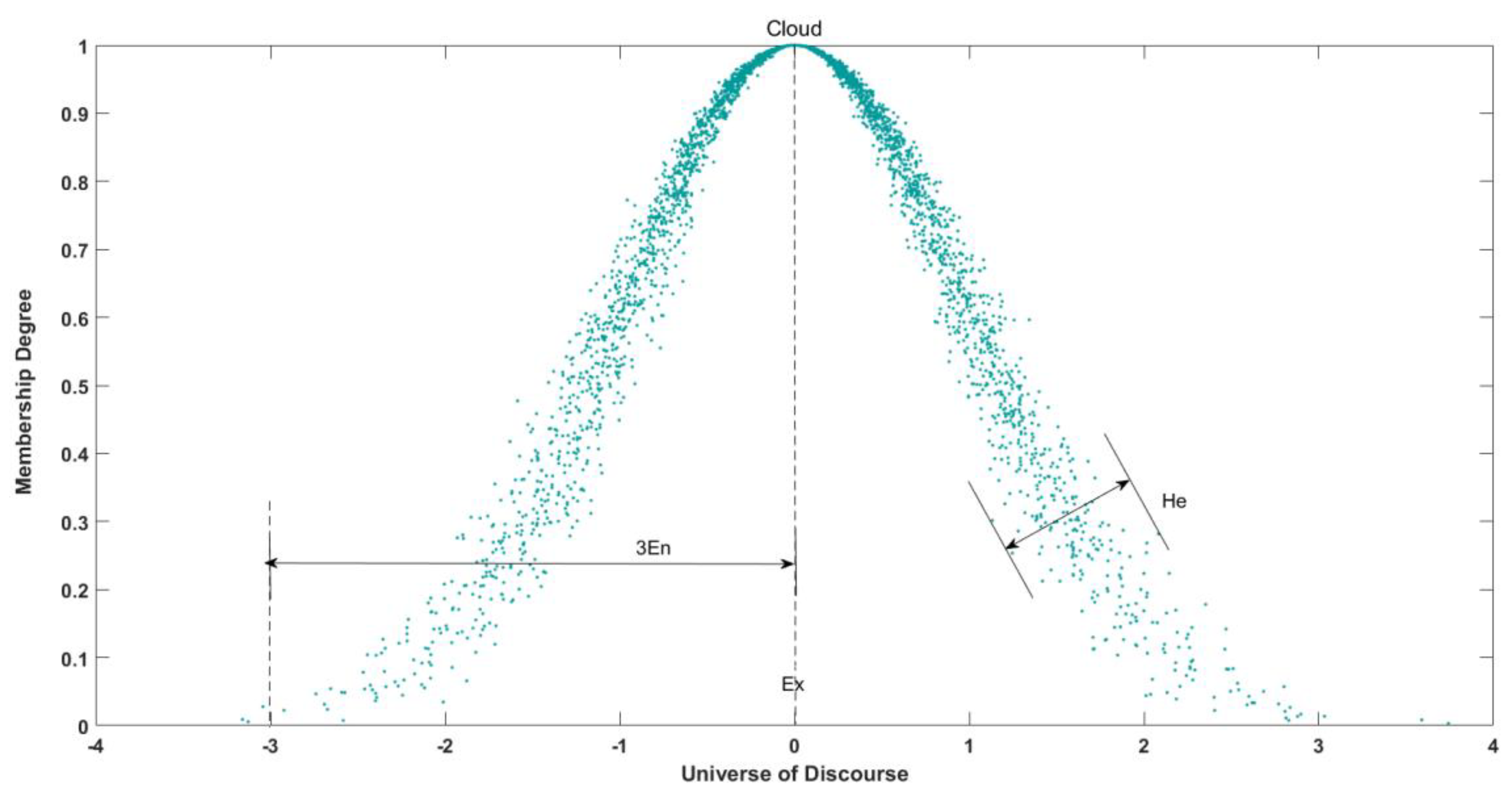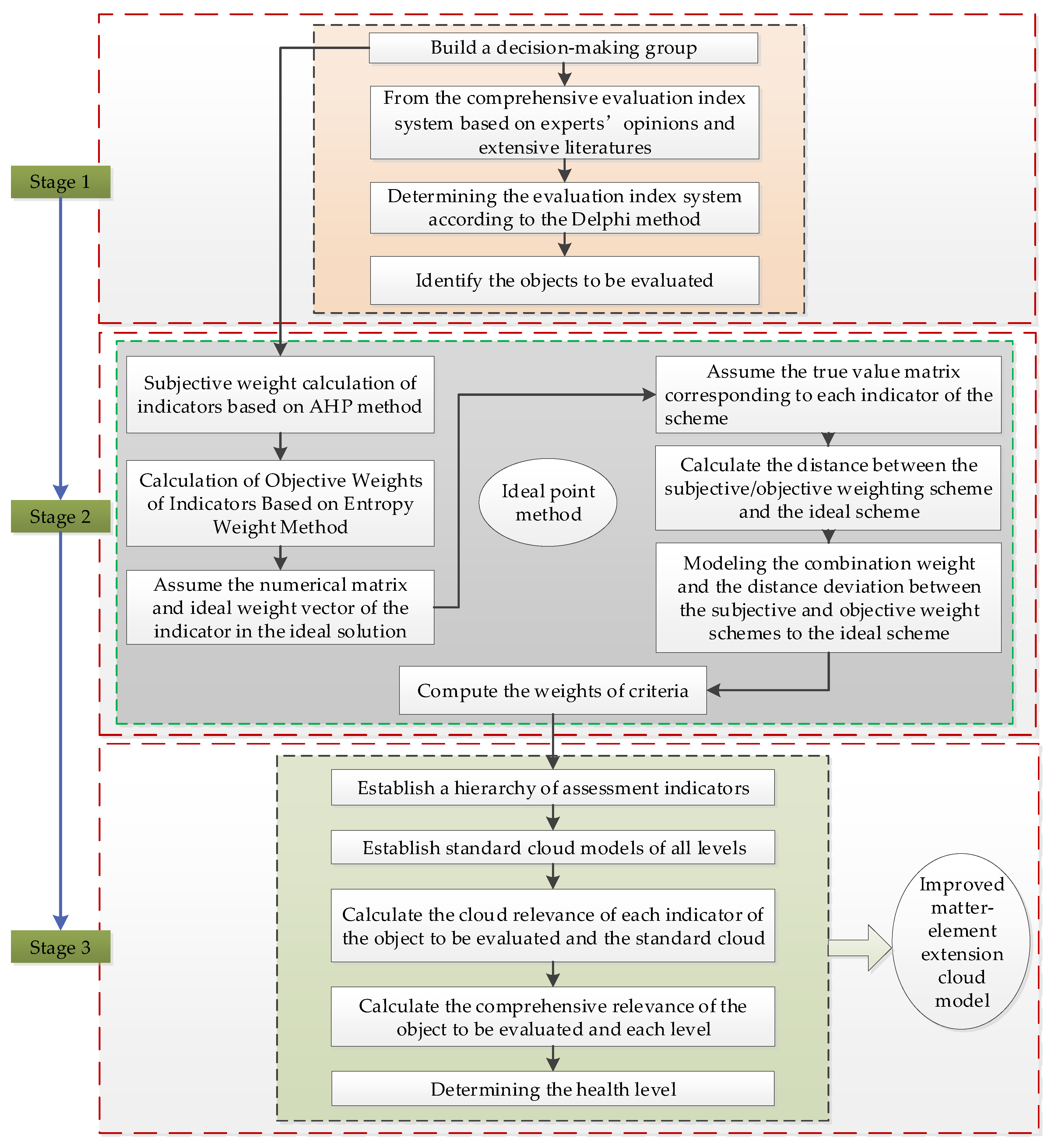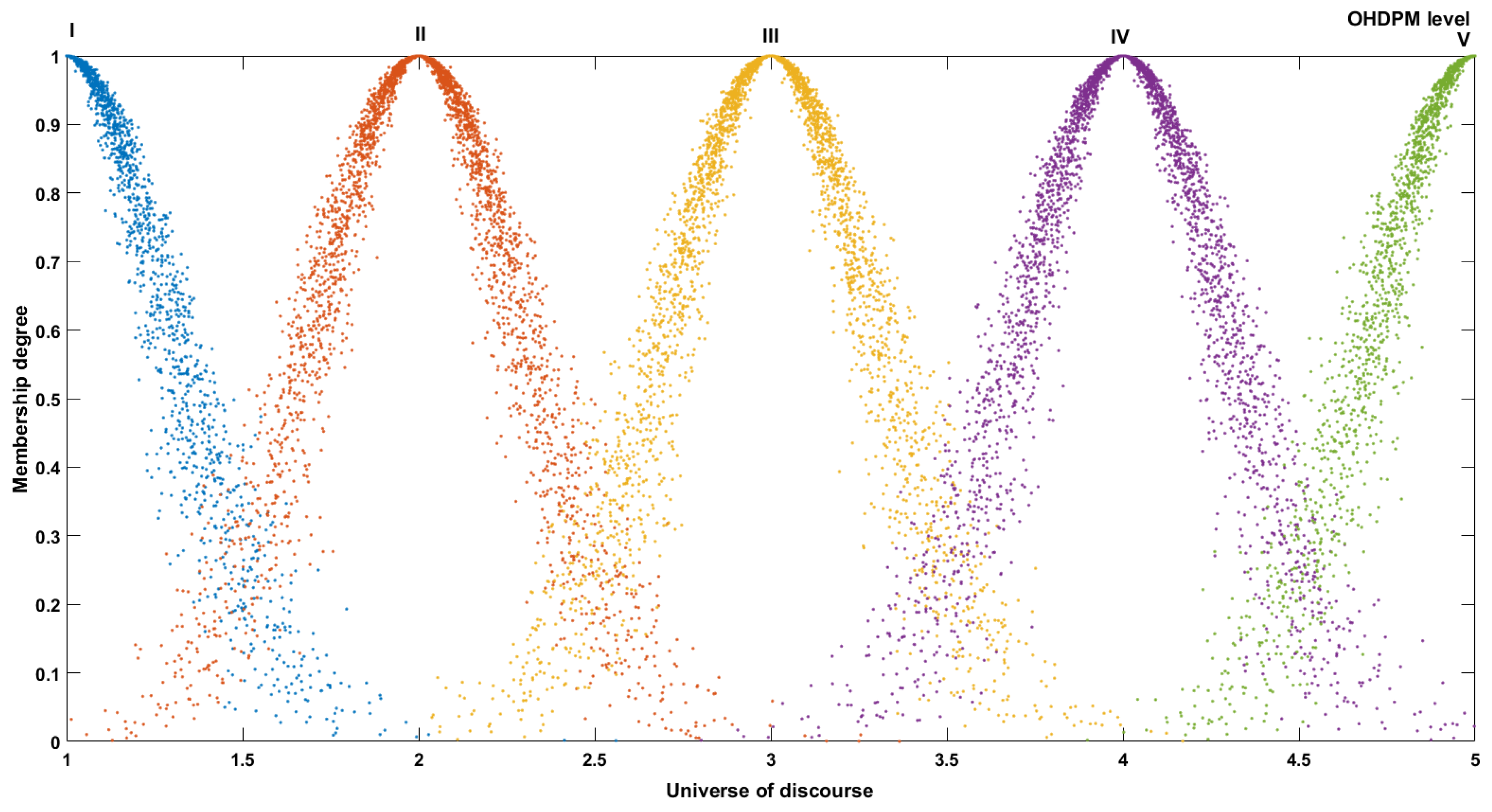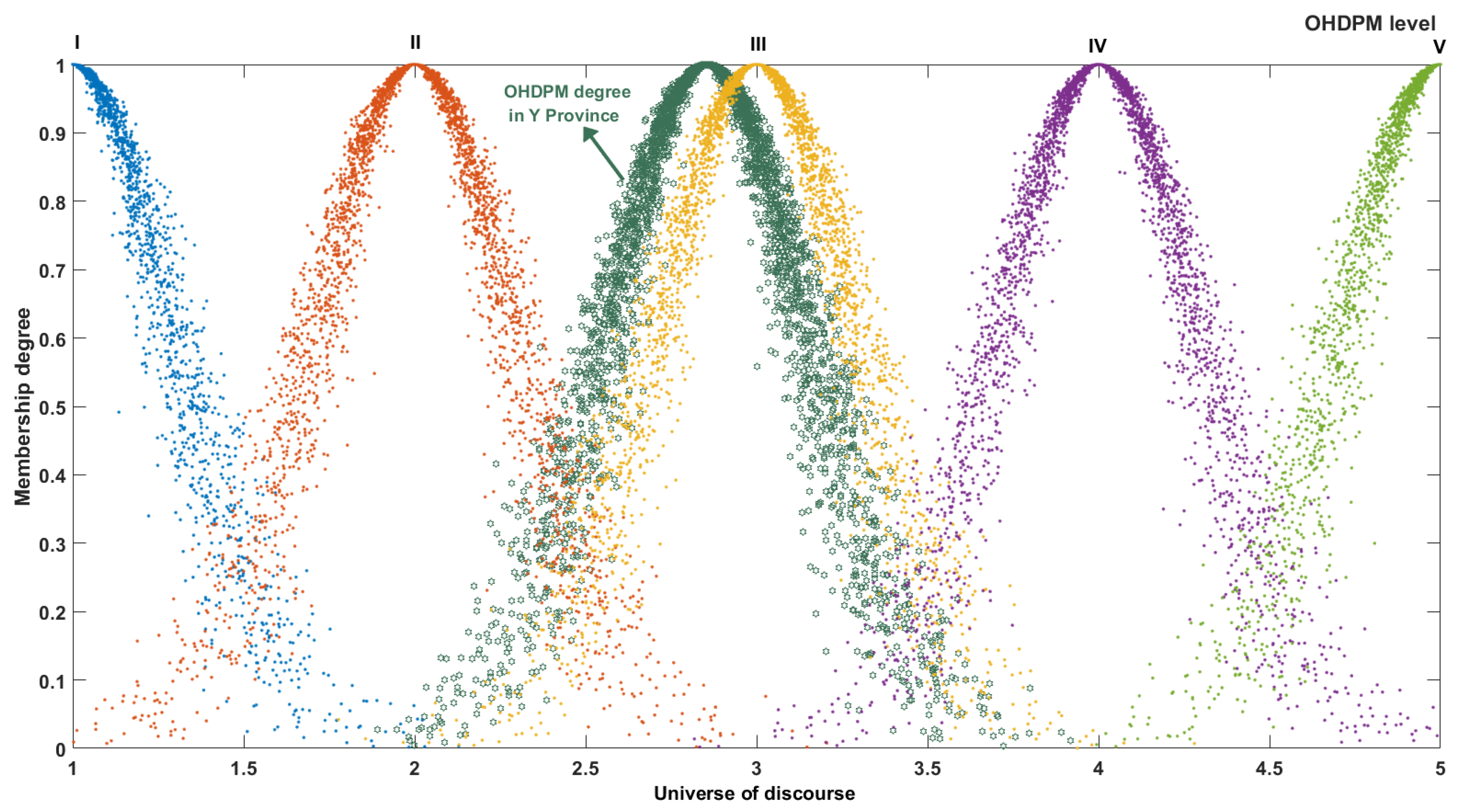In this section, first, the basic theory of MEECM is introduced. Second, we explain how to use IPM to determine index weight and how to use the cloud entropy optimization algorithm to improve the accuracy of entropy. Then, these two methods are applied to MEECM, and the specific implementation steps of OHDPM evaluation are described in detail.
2.2. Method for Determining the Comprehensive Weight of Indicators Based on IPM
The AHP method is an effective system analysis method put forward by Saaty in the 1970s; it is a mature subjective weighting method [
57], but is vulnerable to the subjective limitation of expert opinion. The entropy weight method is a measure of the uncertainty of a system state [
58]. Using the intrinsic information of each scheme, the entropy of each evaluation index can be obtained through the entropy weight method, and then the weight of each index can be obtained. The entropy weight method is more sensitive to the difference of indicators, that is, the difference of sample data of indicators has a greater impact on the weight results.
The determination of weights of OHDPM evaluation indicators is a key step in the comprehensive evaluation process. Because the results of the single weighting method are easily distorted, the AHP and entropy weight methods are used to combine the indicators, and the method of comprehensive weighting of indicators based on ideal points is used to solve the problem. Ideal point method (IPM) is a MCDM method that chooses the best compromise solution from many candidate solutions [
59]. The objective and subjective weights are combined by IPM, which not only reflects the subjective experience of decision-makers, but also makes full use of the original data of indicators, so as to obtain more real and objective weights of indicators. The basic idea is to minimize the deviation between the vector objective function and the ideal point of the problem, and then automatically solve the weight of each index by establishing a mathematical programming model [
60]. The specific steps are as follows.
Step 1: Subjective weight calculation of indicators based on AHP.
Let denote the evaluation indicators and denote expert groups. The weight vector of the subjective weighting method is calculated by AHP and expressed by , where represents the subjective weight of index .
Step 2: Objective weight calculation of indicators based on the entropy weight method.
The weight vector of objective weighting method is obtained through the entropy weight method, which is expressed as , where represents the objective weight of index .
Step 3: Constructing the ideal scheme.
Let the ideal values of each index be expressed by . If the comprehensive weight of indicators based on the ideal point is expressed by , represents the weight of index , and the index value corresponding to the ideal scheme can be expressed by , where denotes the weighted value of index i in an ideal scheme. If the corresponding index values of the schemes to be evaluated are expressed as , then the subjective evaluation results of the schemes to be evaluated are expressed as ; similarly, the objective evaluation results of the schemes to be evaluated are expressed as .
Step 4: Calculating the distance between each scheme and the ideal scheme.
The distance between the
w-weighted schemes to be evaluated and the ideal scheme is expressed by Equation (3):
where
represents the weighted value of index
in the scheme to be evaluated.
The smaller
is, the closer the evaluation scheme is to the ideal one. In order to facilitate calculation, the vectors are united according to Equation (4):
where the united weight vectors are denoted by
,
, and
, respectively. Correspondingly,
,
, and
denote the united weight values of index
in the three different weight solving methods.
The square of the distance between the schemes to be evaluated and the ideal point corresponding to the weights of
,
, and
is expressed by
,
, and
, respectively. The calculation is shown in Equation (5):
Step 5: Constructing the minimum deviation model.
In order to take into account both subjective and objective weights, the combination weights are selected to minimize the weight deviation under subjective and objective combination weights. A nonlinear programming model of the distance deviation from the combination weight, subjective weight and objective weight to the ideal scheme is constructed, the deviation is expressed in
, as shown in Equation (6):
Step 6: Determining the comprehensive weight of indicators.
For the extremum of the function, a Lagrange function is constructed to solve the problem [
61], and then the extreme value of the function
is obtained. By deriving the
function, it is found that when
takes this value, the first derivative is 0 and the second reciprocal is greater than 0, so the function
is convex and the value is the minimum point of it. Through the above analysis, it is found that the value is the solution of combination weight. After normalization, the combination weight can be expressed by Equation (7):
where
.
2.4. OHDPM Evaluation Method Based on Combination Method
2.4.1. The Grade Limit of OHDPM Evaluation Indicators
Referring to the relevant standards [
62] and references [
8,
40,
44], and considering existing research and expert opinions, we have sorted out the hierarchical boundaries of OHDPM impact indicators. Based on the experience of power market operation, we propose a hierarchical division method, that is, the hierarchical I-V corresponds to the lower, low, medium, higher, and high health levels. In addition, the index data of the evaluation object in the evaluation cycle are calculated and used as the basis for evaluation.
2.4.2. Establishment of MEECM with OHDPM Grade Limit
The OHDPM evaluation model is constructed by the matter element extension theory, the index weight determination method based on IPM, the cloud entropy optimization algorithm, and the cloud model. The concrete implementation steps are as follows.
- (1)
Determination of the standard cloud [
56]:
where
represents the
-th (
) health level corresponding to the standard OHDPM.
denotes the
-th health level;
(
) represents an indicator for measuring the OHDPM, that is, the evaluation index.
is the description of the value standard cloud of health level j in the evaluation index
.
- (2)
Determination of the matter element to be evaluated:
where P represents an object to be evaluated;
is the cloud description of the object to be evaluated about its assessment indicator
.
- (3)
Establishing a cloud model of health level boundaries based on various assessment indicators:
Step 1: Determine the expected values of the corresponding indicators for each graded normal cloud model.
First, the grade boundaries of OHDPM’s evaluation indexes are treated as a special double-constraint index
. Then, considering the randomness and fuzziness of the boundary information of the evaluation index classification level, the boundary is moderately expanded, and its parameters are described by ascending and descending semi-normal clouds, as shown in Equation (14) [
8]:
When the left or right boundary is not determined, it can be extended appropriately according to the threshold of the adjacent boundary.
Step 2: Entropy value solution based on the cloud entropy optimization algorithm.
Step 3: Determine the value of hyperentropy.
Let the hyperentropy of index be expressed as , where is a constant that can be adjusted according to the actual situation.
Because
represents the degree of cloud dispersion, the greater the degree of dispersion, the more the overall cloud will show a blurred boundary atomization phenomenon. Through a large number of statistics on the process of cloud atomization in [
63], it is concluded that the critical condition of cloud atomization is
. When
, the cloud begins to atomize. Therefore, this principle is taken into account when selecting
, and different
are tested in the graded normal cloud model; the value that will not cause atomization is chosen as the value of
in this model.
2.4.3. Cloud Association Degree Calculation
The extension cloud correlation degree is a function to evaluate the correlation between a certain index value and a graded normal cloud model. The index value
is regarded as a cloud drop, and then a random number
with mean
and standard deviation
obeying normal distribution is generated. Then the cloud correlation degree
between the target to be evaluated and the OHDPM level extension cloud is calculated, as shown in Equation (15):
Through Equation (15), the extension cloud correlation degree between each index value of the matter element to be evaluated and the standard grade is calculated, and the comprehensive evaluation matrix
of OHDPM level is obtained, as shown in Equation (16):
In the above formula, is the correlation degree between the i-th () index of matter element P to be evaluated and the extension cloud model of the standard grade boundary of grade of OHDPM.
2.4.4. Determination of OHDPM Level
Based on the ideal point combination weighting method [
58], the comprehensive weights of each evaluation index of power market operation health are obtained. The comprehensive evaluation vector of OHDPM level can be obtained by weighting the index weight and cloud correlation degree. The implementation steps for determining the OHDPM level are as follows.
Step 1: Calculation of comprehensive evaluation vector .
The calculation of comprehensive evaluation vectors for OHDPM level evaluation is shown in Equation (17) [
54]:
where
w is the comprehensive weight vector for each evaluation indicator and
K is the comprehensive evaluation matrix.
Step 2: Computation of overall OHDPM evaluation score.
The weighted average method is used to obtain the overall evaluation score once its cloud digital characteristics are represented by A, B, and C, and the calculation methods are as shown in Equation (18):
Step 3: Repeatedly calculate the evaluation score to obtain a more reliable evaluation result.
According to the calculation formula of correlation degree, it can be seen that normal random numbers influence the process of calculating the correlation degree between the index data and the corresponding graded normal cloud model. Therefore, the average value of the evaluation score is obtained by repeated calculation, and the discrete degree of the repeated calculation results is analyzed to judge the fluctuation between the results. The calculation method is shown in Equation (19):
where
is the number of repeated calculations;
is the evaluation score of the health degree obtained by the
t-th operation; and
is the standard deviation of the result calculated by
times.
The expected value can represent the representative OHDPM evaluation score after multiple operations, and the standard deviation can reflect the reliability of the operation results. In order to measure the credibility of the evaluation results, this paper introduces a reliability factor
. The larger the value, the greater the dispersion of evaluation scores and the smaller the credibility. It can be calculated by the formula
[
47].
Therefore, the expected value is regarded as the final evaluation score of OHDPM, that is, .
2.4.5. Determination of OHDPM Level
Through the above steps, we can get the comprehensive evaluation vector ; using the principle of maximum membership degree, we can get the OHDPM level of the object to be evaluated, and the corresponding specific score value is .
2.5. Calculation Framework
The model used to evaluate OHDPM is based on the Delphi method, IPM, and the improved MEECM method.
Figure 2 shows a detailed evaluation process consisting of three stages.
Stage 1: Determine the key evaluation indicators from multiple dimensions, and identify the characteristics of the objects to be evaluated.
In the first stage, experts’ related fields are selected and included in the evaluation team. Then, experts are invited to conduct semi-closed questionnaires through the Delphi method, and the key indicators for evaluating OHDPM are determined.
Stage 2: The weights of indicators are determined based on the comprehensive weight calculation method of ideal points.
To determine the weights of criteria with IPM, the subjective weight and objective weight of the index are first calculated by the AHP and entropy weight methods. Then, the ideal scheme of OHDPM is constructed. Third, the distance between the objective and subjective weight corresponding schemes and the ideal scheme is established. Fourth, a nonlinear programming model of distance deviation from the combination weight, subjective weight, and objective weight scheme to the ideal scheme is constructed. Finally, a Lagrange function is constructed to solve the programming model, and the final combination weight is obtained.
Stage 3: Evaluate the OHDPM status by the improved MEECM method.
In this stage, the first step is to determine the level boundaries of OHDPM evaluation indicators, then calculate the cloud eigenvalues corresponding to each level of OHDPM, and establish graded normal cloud models of OHDPM. Next, the cloud correlation degree between each index of the object to be evaluated and the graded normal cloud model is calculated. Finally, the comprehensive correlation degree between the object to be evaluated and each level is calculated, and the OHDPM level is determined according to the principle of maximum membership degree.
The hybrid evaluation model, which combines the index weighting method of IPM and the improved MEECM method, has three advantages for evaluating OHDPM. The hybrid evaluation model, which combines the index weighting method of the ideal point and the improved MEECM method, has three advantages when evaluating OHDPM. First, the framework allows the membership degree to fluctuate randomly within the range determined by the central value, and achieves a reasonable transformation from qualitative concept to quantitative expression. Second, the comprehensive weight determination method based on ideal points is different from the traditional weighting method. It does not weigh the subjective and objective weights linearly, but realizes the optimal weight of adaptive adjustment according to the actual situation of the index. Finally, by improving the cloud entropy optimization algorithm and taking into account two kinds of cloud entropy calculation rules, the phenomenon of contradictory evaluation results is avoided, and evaluation results with high reliability are produced. Therefore, the hybrid model is suitable for dealing with practical problems.









